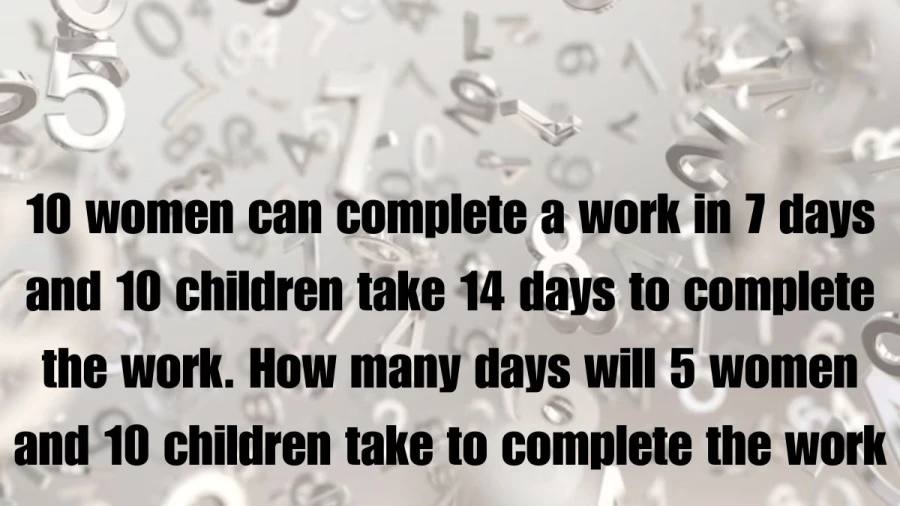If you happen to be viewing the article 10 women can complete a work in 7 days and 10 children take 14 days to complete the work. How many days will 5 women and 10 children take to complete the work? ? on the website Math Hello Kitty, there are a couple of convenient ways for you to navigate through the content. You have the option to simply scroll down and leisurely read each section at your own pace. Alternatively, if you’re in a rush or looking for specific information, you can swiftly click on the table of contents provided. This will instantly direct you to the exact section that contains the information you need most urgently.
Find out: if 10 women take a week to complete something, and 10 children take two weeks, how many days will it take for 5 women and 10 children combined?
10 women can complete a work in 7 days and 10 children take 14 days to complete the work. How many days will 5 women and 10 children take to complete the work?
5 women and 10 children together will take 7 days to complete the work.
From the given information:
-
10 women can complete the work in 7 days.
-
So, the rate of 1 woman = 1/(10 * 7) = 1/70 of the work per day.
-
10 children can complete the work in 14 days.
-
So, the rate of 1 child = 1/(10 * 14) = 1/140 of the work per day.
Now, we calculate the combined rate of 5 women and 10 children:
Combined rate = (5 * rate of 1 woman) + (10 * rate of 1 child) = (5 * 1/70) + (10 * 1/140) = (5/70) + (10/140) = (1/14) + (1/14) = 1/7
So, 5 women and 10 children together can complete 1/7 of the work per day.
To find out how many days they will take to complete the entire work, we divide the total work by their combined rate:
Total work = 1 (since they need to complete the whole work)
Number of days = Total work / Combined rate = 1 / (1/7) = 7 days
Therefore, 5 women and 10 children together will take 7 days to complete the work.
Time and Work in Mathematics
Time and work problems in mathematics involve calculating the amount of work done by a person or a group of people working together over a certain period of time. These problems typically require understanding the rates at which individuals or groups work and how those rates combine to complete a task.
Here are some common concepts and approaches used in solving time and work problems:
-
Basic Formula: The basic formula used in time and work problems is: Work = Rate × Time
-
Inverse Proportionality: If more people are working on a task, the time required to complete the task decreases, and vice versa. This is represented as an inverse proportionality.
-
Work Rate: Each individual’s work rate is the amount of work they can do in one unit of time. For example, if a person can complete 1/8 of a job per hour, their work rate is 1/8 job per hour.
-
Combined Work Rate: When multiple people work together, their individual work rates add up to give the combined work rate. For instance, if person A can complete 1/6 of a job per hour and person B can complete 1/4 of the job per hour, then together, their combined work rate is 5/12 job per hour.
-
Fractional Work: Sometimes, a portion of the work is done before another portion starts. In such cases, the work done is considered as a fraction of the total work.
-
Solving Equations: Time and work problems often require setting up equations based on the given information and then solving for the unknowns. These equations may involve rates, times, and fractions of work completed.
-
Unit Conversion: Make sure all units (hours, days, etc.) are consistent throughout the problem. Convert if necessary to ensure uniformity.
-
Practice: Practice is key to mastering time and work problems. Try solving a variety of problems to get comfortable with the concepts and techniques involved.
Let’s illustrate these concepts with an example:
Example: If it takes 8 hours for 6 workers to complete a task, how many hours will it take for 3 workers to complete the same task if they work at the same rate?
Solution: Let’s denote the time it takes for 3 workers to complete the task as t hours. Using the concept of combined work rate, we can set up the equation:
6 × 8 = 3 × t 48 = 3t t = 48/3 = 16
So, it will take 16 hours for 3 workers to complete the same task.
Thank you so much for taking the time to read the article titled 10 women can complete a work in 7 days and 10 children take 14 days to complete the work. How many days will 5 women and 10 children take to complete the work? written by Math Hello Kitty. Your support means a lot to us! We are glad that you found this article useful. If you have any feedback or thoughts, we would love to hear from you. Don’t forget to leave a comment and review on our website to help introduce it to others. Once again, we sincerely appreciate your support and thank you for being a valued reader!
Source: Math Hello Kitty
Categories: Math

